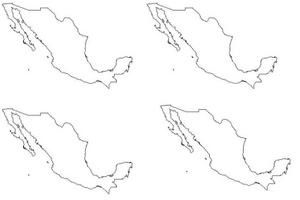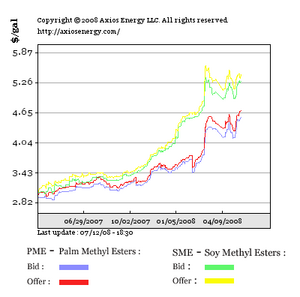Para sustituir el petroleo mexicano por biodisel, se necesita 350 veces el volumen de agua del lago Chapala y cultivar 4 veces la superficie total del país

- Producción mexicana de petróleo : 3.7 millones de barriles por día = 3,700,000 X 159 X 365 = 214,729,000,000 litros por año (Fuente: US Department of Energy, 2006)
- La demanda en energía aumenta en todo el mundo (y en México también). Segun la Agencia Internacional de la Energia, esta demanda estara en 2050 3 veces superior a la demanda actual.
1 - ¿Cuántos kilometros cuadrados de maíz, de soya, de girasol o de Higuerilla se necesitan para producir 214,729,000,000 litros equivalente petróleo?
Rendimiento bruto* :
- Maíz: 17,200 litros de aceite por km2 de cultivo
- Soya : 44,600 litros de aceite por km2 de cultivo
(Fuente: Yusuf Chisti, Biotechnology Advances 25 (2007) 294–306, http://www.massey.ac.nz/~ychisti/Biodiesel.pdf)
- Girasol (igual con Higuerilla): 100,000 litros de aceite por km2 de cultivo.
- Maíz: 214,729,000,000 / 17,200 = 12.5 millones de km2
- Soya: 214,729,000,000 /44,600 = 4 .8 millones de km2
- Girasol (igual con Higuerilla): 214,729,000,000 /100,000= 2.2 millones de km2
Superficie de México : 1.9 millones de Km²
 Entonces se necesitan 6.5 veces la totalidad de la superficie de México para remplazar el petróleo que produce México por aceite de maíz, 2.5 veces por aceite de Soya, y un poco mas que la totalidad de la superficie de México con el girasol. Y si tomamos en cuanta toda la energia consumida para cultivar la planta (trabajo de la tierra, sintesis de los pesticidas, de los fertilizantes, irrigación etc.), para extraer el aceite, transportarlo, y para transformar el aceite en biodisel, llegamos a un rendimiento neto mucho inferior al rendimiento bruto (30 a 50% menos). Entonces, se debe cultivar todavía más. Multiplicar las superficies por 1,5 a 2. En lo que se refiere al etanol el rendimento neto es nullo (o negativo...), entonces no se puede calcular las superficies necesarias: son infinitas. Ver por ejemplo estos estudios:
Entonces se necesitan 6.5 veces la totalidad de la superficie de México para remplazar el petróleo que produce México por aceite de maíz, 2.5 veces por aceite de Soya, y un poco mas que la totalidad de la superficie de México con el girasol. Y si tomamos en cuanta toda la energia consumida para cultivar la planta (trabajo de la tierra, sintesis de los pesticidas, de los fertilizantes, irrigación etc.), para extraer el aceite, transportarlo, y para transformar el aceite en biodisel, llegamos a un rendimiento neto mucho inferior al rendimiento bruto (30 a 50% menos). Entonces, se debe cultivar todavía más. Multiplicar las superficies por 1,5 a 2. En lo que se refiere al etanol el rendimento neto es nullo (o negativo...), entonces no se puede calcular las superficies necesarias: son infinitas. Ver por ejemplo estos estudios:
> David Pimentel, Tad W. Patzek, Ethanol Production Using Corn, Switchgrass, and Wood; Biodiesel Production Using Soybean and Sunflower, Natural Resources Research, Vol. 14, No. 1 (March 2005) - Abstract: Energy outputs from ethanol produced using corn, switchgrass, and wood biomass were each less than the respective fossil energy inputs. The same was true for producing biodiesel using soybeans and sunflower, however, the energy cost for producing soybean biodiesel was only slightly negative compared with ethanol production. Findings in terms of energy outputs compared with the energy inputs were: • Ethanol production using corn grain required 29% more fossil energy than the ethanol fuel produced. • Ethanol production using switchgrass required 50% more fossil energy than the ethanol fuel produced. • Ethanol production using wood biomass required 57% more fossil energy than the ethanol fuel produced. • Biodiesel production using soybean required 27% more fossil energy than the biodiesel fuel produced (Note, the energy yield from soy oil per hectare is far lower than the ethanol yield from corn). • Biodiesel production using sunflower required 118% more fossil energy than the biodiesel fuel produced.
http://petroleum.berkeley.edu/papers/Biofuels/NRRethanol.2005.pdf
> X. Chavanne, J.-P. Frangi, Le rendement énergétique de la production d'éthanol à partir de maïs, C. R. Geoscience 340 (2008) - Abstract: Energy yield for the production of ethanol from corn. This article establishes the primary energy balance for making ethanol out of corn in the USA, calculated from the farm to the fuel station, following a methodology described in Chavanne and Frangi (C. R. Geoscience 339 (2007) 519–535). Raw data (direct energy and material consumption as well as their heat value and external costs) come from published papers related to this topic, technical textbooks, as well as reports from the US Departments of Agriculture and Energy. For the 2001 harvest, over the area producing more than 90% of ethanol and for the 2005 network of working refineries, 100 J of ethanol and recovery of by-products (the energy saved by the replacement of animal feed by these byproducts is around 12% of the ethanol heat value) needed 86+/-3 J of energy spending, of which more than 50 J is natural gas and 62 J is used in refineries. A third of the area of Nebraska corn must be irrigated with water pumped from underground, at an added cost of 26+/-3 J. In 1996, the extra drying required, because of heavy rains, added 6 J. By comparison, 100 J of gasoline cost less than 25 J to be produced out of crude oil. Complementary studies of resource availability are not performed here. The largest possible reduction in energy costs can be achieved at the refinery stage, by fermenting by-products, gas residues, (from 62 J to around 12 J). The article gives also an expression for the expenditure to enable comparison between different energy systems, including everything from biomass to transport. For the ethanol case, the average cost is 130 J for 100 J of corn grain heat.
http://www.academie-sciences.fr/publications/comptes_rendus/pdf/CRGeoscience_article.pdf
> E. Marcelo & al, Bioscience, Ethanol as Fuel: Energy, Carbon Dioxide Balances, and Ecological Footprint, Bioscience, 2007 - Abstract: This peer-reviewed resource from Bioscience is about Ethanol. The major contributor to global warming is considered to be the high levels of greenhouse gas emissions, especially carbon dioxide (CO2), caused by the burning of fossil fuel. Thus, to mitigate CO2 emissions, renewable energy sources such as ethanol have been seen as a promising alternative to fossil fuel consumption. Brazil was the world's first nation to run a large-scale program for using ethanol as fuel. Eventually, the United States also developed large-scale production of ethanol. In this study, we compare the benefits and environmental impacts of ethanol fuel, in Brazil and in the United States, using the ecological footprint tool developed by Wackernagel and Rees. We applied the STELLA model to gauge possible outcomes as a function of variations in the ethanol production scenario.
http://www.biosciednet.org/portal/search/browse.php?step=3&nav=college&by=resourceType&filter=college&value=Journal&recordID=9059
Hay que añadir que toda la superficie de México no es cultivable (montañas, zonas áridas, zonas naturales, ciudades etc.). Y toda la superficie cultivable no puede ser utilizada para producir carburantes: necesitamos alimentos para comer y para la ganadería!
Y por fin el poder calorifico del biodisel es inferior al del disel del petroleo...Se debe cultivar superficies todavia mas grandes...
 2 - ¿Qué cantidad de agua se consume para cultivar el maíz?
2 - ¿Qué cantidad de agua se consume para cultivar el maíz?
Para cultivar el maíz se necesita 250,000 m3 de agua por km2 y por año.
Para cultivar 12.5 millones de km2, se necesita:
250,000 X 11,300,000 = 3,125,000,000,000 m3
= 325 veces el volumen de agua del lago Chapala
 - México hace parte de los países en zona roja en cuanto a la disponibilidad en agua:
- México hace parte de los países en zona roja en cuanto a la disponibilidad en agua:
http://assets.panda.org/img/original/waterscarcitymap.jpg
http://www.oieau.fr/ciedd/contributions/at2/contribution/images/image145.gif
- La población humana crece rápidamente y ya vivimos una crisis alimentaría grave:
- El cambio climático afecta el ciclo del agua: http://www.ipcc.ch
3 - Podemos hacer cálculos similares con la cuantidad de pesticidas y de fertilizantes químicos que se utilizan para el cultivo del maíz y que luego se diseminan en el medio-ambiente (impacto sobre la salud humana y la biodiversidad).
4 - Cuando se produce el biodisel (trans-esterificación), se produce grandes cuantidades de glicerina (toxica). Cuando se quema el biodisel en el motor de un carro, se contamina el aire con los productos de la combustión (la acroleina es cancerigena).
En cuanto al etanol, su combustión tiene consecuencias sanitarias graves. Ver por ejemplo:
Mark Z. Jacobson, Effects of Ethanol (E85) Versus Gasoline Vehicles on Cancer and Mortality in the United States, 2007
http://www.stanford.edu/group/efmh/jacobson/E85PaperEST0207.pdf
5 - Evolución del precio del biodisel: Sigue la alza del baril de petroleo, entonces solo los ricos van a poder comprarlo.

